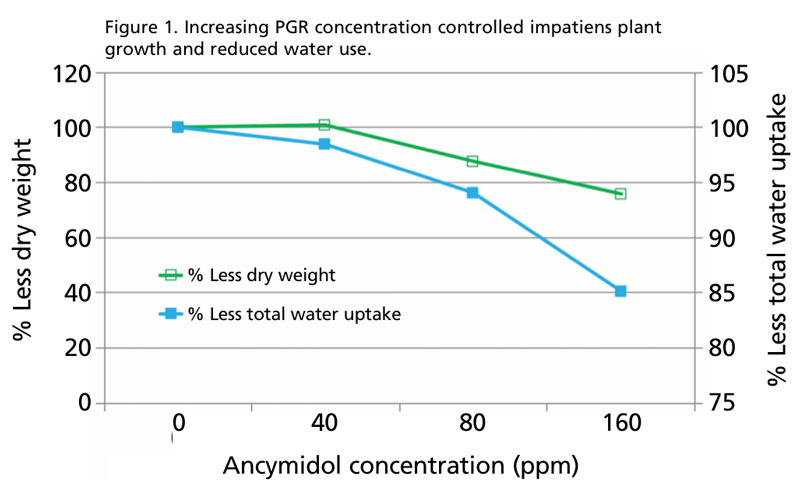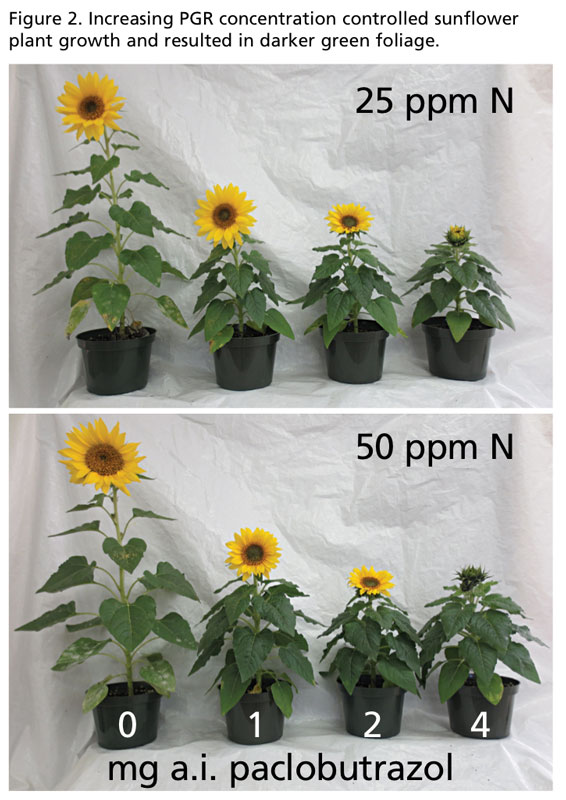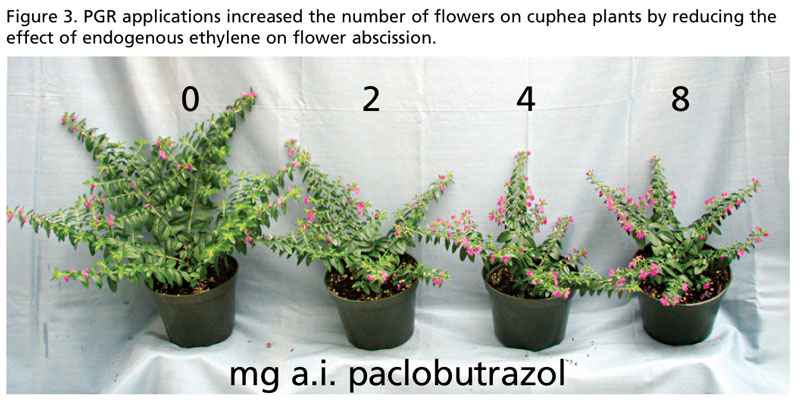7/1/2018
Striving for the Perfect Plant
John Dole, Ifitkhar Ahmad & Brian Whipker
Trying to grow the perfect petunia or poinsettia? Chances are plant growth regulators (PGRs) are an important part of the production recipe. They control stem elongation, producing shorter, more compact plants that look proportionate to the container and show the flowers well.
 For some crops, such as vegetatively propagated petunia and sweet potatoes, this also means keeping unruly stems from becoming intertwined, making packing and shipping a nightmare. PGRs result in stocky, durable plants that are better able to withstand the rigors of packing and shipping on racks, or worse, bouncing around in the backseat or trunk of a customer’s car. Of course, we cannot forget the economics of PGRs in allowing us to produce more plants per area, helping us to make a profit.
For some crops, such as vegetatively propagated petunia and sweet potatoes, this also means keeping unruly stems from becoming intertwined, making packing and shipping a nightmare. PGRs result in stocky, durable plants that are better able to withstand the rigors of packing and shipping on racks, or worse, bouncing around in the backseat or trunk of a customer’s car. Of course, we cannot forget the economics of PGRs in allowing us to produce more plants per area, helping us to make a profit.
PGRs do much more, however. In a recent series of experiments, we looked at the effects of PGRs on a variety of other factors, such as water use, fertilizer use, ethylene sensitivity and postharvest handling.
Water use
While PGRs produce more compact growth, they typically don’t reduce the number of leaves, which raises the question of whether or not PGRs reduce water use.
We studied the effects of paclobutrazol on potted sunflower and zinnia, and ancymidol on impatiens, marigold, petunia and zinnia plugs. Paclobutrazol was either applied as a drench at 0, 1.0, 2.0 or 4.0 mg of active ingredient per 6-in. pot for sunflower, or 0, 0.5, 1.0 or 2.0 mg per 4-in. pot for zinnia, while ancymidol was applied at 0, 40, 80 or 160 ppm as a foliar spray. With an increase in paclobutrazol dose or ancymidol concentration, plant growth (fresh weight, dry weight, plant height and diameter) and total water use was lowered for all species tested.
For potted sunflower, 2.0 mg of paclobutrazol resulted in 31.5% less water use compared with non-treated plants. For potted zinnia, plants treated with 1.0 mg paclobutrazol used 45% less water. For plugs, a foliar application of ancymidol at 80 to 160 ppm lowered water use by 6% to 15 % for impatiens, 7% for marigold (160 ppm only), 17% to 25% for petunia, and 10% to 18% for zinnia. Thus, application of PGRs not only inhibited excessive plant growth, but also reduced the amount of water needed to produce the crop (Figure 1).

Fertilizer use
PGRs are known to help produce darker green foliage, but what effect do they have on the amount of fertilizer that needs to be used to grow a crop?
Paclobutrazol was applied as a drench at 0, 1.0, 2.0 or 4.0 mg of active ingredient per 6-in. pot for sunflower and 0, 0.5, 1.0 or 2.0 mg per 4-in. pot for zinnia, while ancymidol was applied at 0, 40, 80 or 160 ppm as a foliar spray on marigold and petunia plugs.
With an increase in paclobutrazol dose or ancymidol concentration, plant growth, plant height and diameter (potted plants only), shoot fresh weight or dry weight was controlled for all species tested. The application of PGRs increased the concentration of N, P, K, Mg and Ca in plant tissue. The increase was great enough in marigold, sunflower and zinnia that the highest rate of PGR application at each fertilizer rate resulted in tissue nutrient levels similar to a low rate of PGR, but the next higher rate of fertilizer.
For example, zinnia plants grown with 50 ppm N and 2 mg a.i. paclobutrazol had similar tissue levels of nutrients as plants grown with 100 ppm N and no PGR. Results were more dramatic when looking at leaf color. Sunflower and zinnia plants grown with 25 ppm N and the highest PGR drench rate had darker green leaves than plants grown at 50, 100 or 200 ppm N without PGRs (Figure 2).
Ethylene sensitivity
Many bedding and potted flowering plants are sensitive to ethylene exposure, which can cause abscission of flowers and leaves, yellowing of foliage and a shortened shelf life. However, do PGRs affect ethylene sensitivity?
Paclobutrazol was applied as a drench at 0, 1.0, 2.0 or 4.0 ppm per 5-in. pot for cuphea, or 0, 2.0, 4.0 or 8.0 ppm per 6-in. pot for petunia, while uniconazole was applied at 0, 2.0, 4.0 or 8.0 ppm as a foliar spray for portulaca plugs. With an increase in paclobutrazol dose or uniconazole concentration, plant growth, plant height and diameter (potted plants only), shoot fresh weight or dry weight was controlled for all species tested.
 In addition, PGR-treated plants were just as sensitive to exogenous ethylene as untreated plants. Surprisingly, however, both PGRs prevented flower abscission from ethylene that the plant normally produces (endogenous). Thus, PGR-treated plants were not only more compact, but also retained more flowers (Figure 3).
In addition, PGR-treated plants were just as sensitive to exogenous ethylene as untreated plants. Surprisingly, however, both PGRs prevented flower abscission from ethylene that the plant normally produces (endogenous). Thus, PGR-treated plants were not only more compact, but also retained more flowers (Figure 3).
Postharvest handling
While PGRs are useful in helping to avoid physical damage from packing, shipping and marketing, what effect do they have on other postharvest attributes, such as leaf yellowing, wilting and shelf life?
Paclobutrazol was applied as a drench at 0, 1.0, 2.0 or 4.0 mg of a.i. per 6-in. pot for sunflower and 0, 0.5, 1.0 or 2.0 mg per 5-in. pot for zinnia, while ancymidol was applied at 0, 40, 80 or 160 ppm as a foliar spray for marigolds or petunia plugs. With an increase in paclobutrazol dose or ancymidol concentration, plant growth (plant height and diameter, shoot fresh or dry weight) was controlled for all species tested.
Use of 1.0 to 2.0 mg paclobutrazol per pot produced 21% to 28% shorter plants with 12% to 15% smaller plant diameter, 13% to 19% less shoot fresh weight, 15% to 21% less dry weight and darker green foliage color for potted sunflower than non-treated plants. Treatment with 1.0 to 4.0 mg paclobutrazol per pot delayed first wilting by 0.7 to 1.4 days compared with non-treated plants.
For zinnia, 0.5 to 1.0 mg paclobutrazol controlled plant growth, produced dark green foliage and extended shelf life by delaying first wilting by 2.6 to 3.9 days and second wilting by 1.4 to 2.0 days than non-treated plants. For marigold and petunia plugs, 40 to 80 ppm ancymidol provided ample growth control with darker green foliage; however, postharvest longevity was extended only when plugs were sprayed with 160 ppm ancymidol.
During simulated storage and shipping, PGRs maintained darker green foliage for potted sunflower, zinnia and marigold plugs, and prevented postharvest stem elongation of petunia plugs.
Summary
PGRs not only result in compact, durable plants, but also reduce the amount of water and fertilizer needed to grow the plants, potentially saving growers additional dollars. PGRs increased the shelf life of plants by preventing internal ethylene from causing flower drop and keeping the plants greener and less sensitive to drying out, depending on the concentrations used.
Of course, each producer will have to balance the benefits of PGRs with the cost of the applications and the labor needed to make them. GT
Acknowledgements: A big thank you to the Floriculture and Nursery Research Initiative for funding this work, to Ingram McCall for helping with plant production and testing, and to James Atland for analyzing the tissue nutrient levels in his lab.
John Dole (jmdole@ncsu.edu) is a Professor and Associate Dean & Director of Academic Programs for the College of Agriculture and Life Sciences at NC State University. Ifitkhar Ahmad (iftikharahmadhashmi@gmail.com) is a former Research Associate in the Cut Flowers and Postharvest Floriculture Program in the Department of Horticultural Science at NC State University and is currently on faculty at the University of Agriculture, Faisalabad, Pakistan. Brian Whipker (bwhipker@ncsu.edu) is a Professor and Assistant Department Head in the Department of Horticultural Science at NC State University.